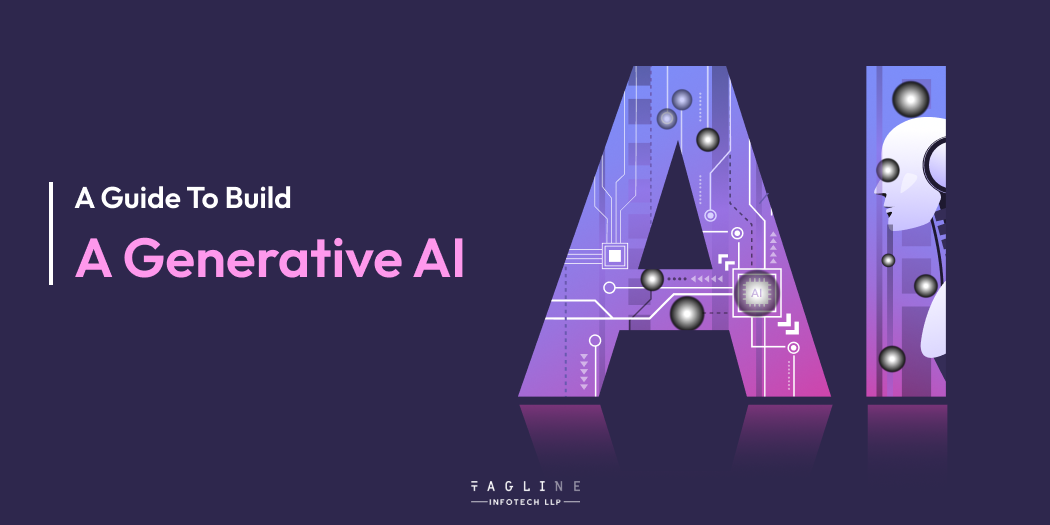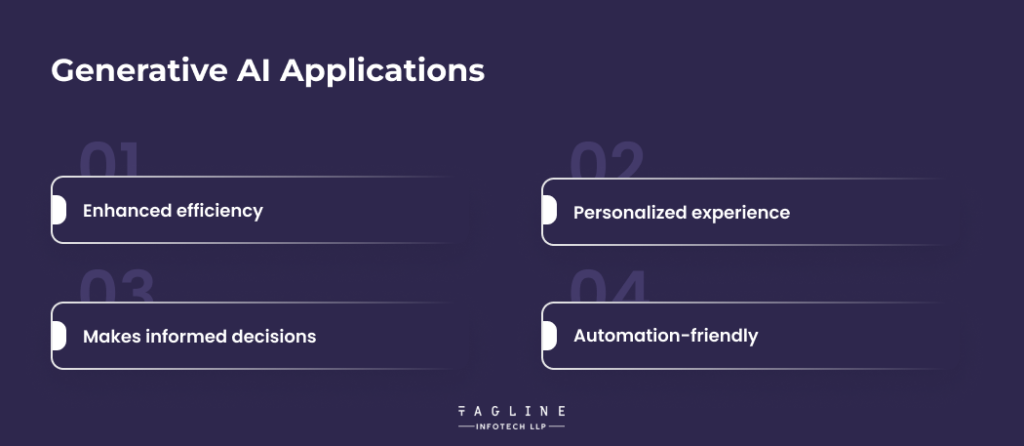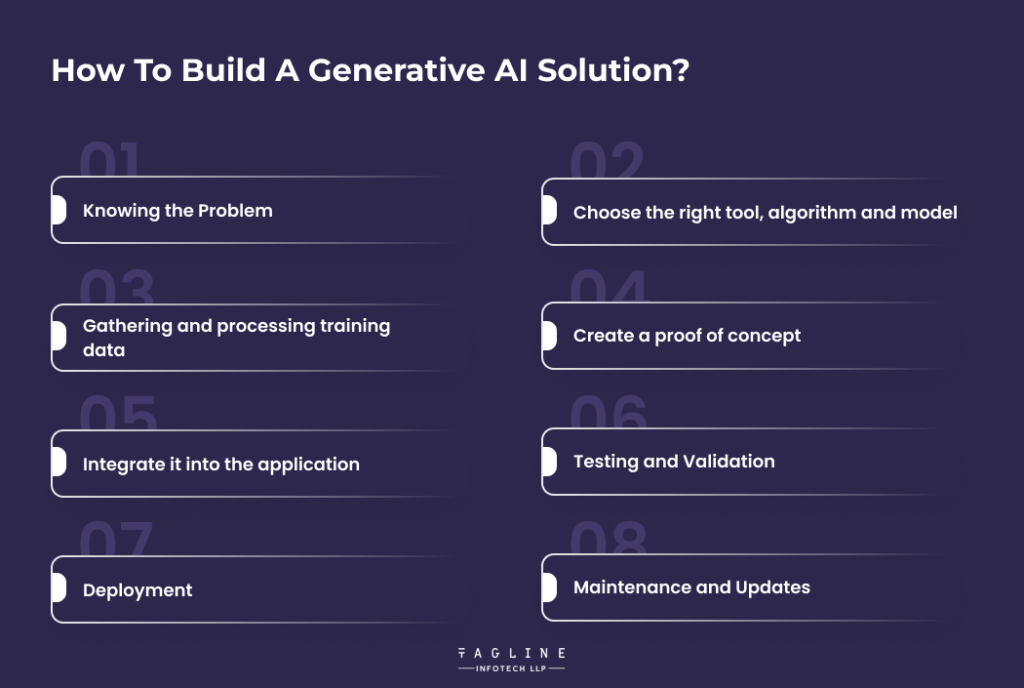A List of The 25 Best Ruby on...
May 8, 2024
Home >> AI >> A Guide To Build A Generative AI

Quick Summary
Businesses and entrepreneurs interested in bootstrapping their ventures can benefit significantly from applying generative artificial intelligence technologies. Venture capitalists find the statistics displayed here impressive as nicely.
A subset of artificial intelligence called generative artificial intelligence, or Gen AI, can produce content or data independently. This covers the creation of photos, text, whole databases, and other kinds of material. It provides the content by generating vast user input data. Numerous applications of generative artificial intelligence exist, such as producing words and images and developing chatbots that imitate human behaviour.
Many generative artificial intelligence models are currently available, each specifically designed for a particular task or application scenario. Generative artificial intelligence can be applied in a wide range of contexts and efficiently used to meet the needs of researchers and businesses due to its diversity.
This is the global market share of models for generative artificial intelligence, even though a significant language model dominates the market.
Selecting the right generative would directly impact how effective your Generative AI solution is. Each type of data model has unique characteristics that set it apart, ranging from data need and interpretability to job fit. In light of this, let’s examine some of the most well-liked Gen AI models.
Distinguished by its adversarial nature, this deep learning model consists of two neural networks: the discriminator and the generator.
Imagine the following situation: someone is trying to make money as an artist (the generator), and someone else is a skilled investigator (the discriminator) trying to spot fakes. They compete and work together to get better at what they do. Both the investigator and the artist keep honing their counterfeiting skills, and the detective gets better at spotting fakes. In their rivalry, the artist produces fake money (or data) so lifelike that not even the investigator can tell it apart from the genuine thing.
This dynamic equilibrium creates unique creations like lifelike graphics, realistic language, or style transfer.
Large neural networks have been used to develop these advanced natural language processing systems, which have been pre-trained on enormous datasets to produce text comparable to human writing on various topics and activities.
With their powers, these models can produce text, translate it, summarize it, pose queries, offer helpful applications, and even write code.
Despite their extraordinary powers, they also present issues with ethical use, privacy, and the responsible development of artificial intelligence. Therefore, cautious oversight and reliable application are required in several disciplines.
This generative model aims to estimate intricate probability distributions across datasets. Its goal is to aid computers in comprehending complex objects by decomposing them into more manageable chunks. It also helps to clarify an unclear image.
Unlike traditional generative models like autoregressive or Markov models, diffusion models use an iterative process to refine the data distribution gradually.
This generative AI model works well for picture creation, inpainting, denoising, data imputation, and other uses.
An encoder-decoder architecture is used in this generative artificial intelligence model to collect and generate complex data distributions. This approach captures and leverages the combined power of probabilistic modelling and autoencoders.
When a vector approximation engine (VAE) is employed, the encoder maps the input data to a learned distribution housed in a reduced-dimensional latent space. This technique can be used to encode complex data into a compact and continuous representation. The abovementioned process is reversed when the decoder maps the data from the latent space to its original form.
What distinguishes VAEs from other models is their capacity to replicate data and investigate a latent universe of possibilities. With the use of VAEs, it is possible to create realistic graphics, audio, texts, art synthesis, anomaly detection, and other applications.
Transformer-based models provide exceptional performance in various tasks, including information retrieval, text creation, language translation, and more—robust machine learning and natural language processing power these models.
The most significant advance transformers may provide is the ability to parallelize data processing, which is enabled by the self-attention mechanism. Additionally, transformers excel in capturing long-distance dependencies within sequences; this exceptional ability allows them to handle complex relationships and context in language.
“Top 5 Artificial Intelligence Applications in 2023 “
– Also Read Article

Here is the list of Generative AI applications for you:
Generative artificial intelligence directly affects corporate efficiency by allowing experts to do repetitive tasks faster. For example, artificial intelligence (AI) software may help marketers create a marketing plan in seconds, whereas the process would often take several hours. You’ll have more energy to dedicate to other endeavours that call for creativity or social contact.
Information about your goods and services can be added to already-trained generative artificial intelligence models to improve them even more. You may engage customers by improving their journey experience with automated, pertinent, customized responses.
A multilayer neural network, the core of generative artificial intelligence, can process massive amounts of data. Companies can use the AI engine to help in decision-making by reducing the likelihood of expensive mistakes.
Many businesses are streamlining their operations to encourage greater employee collaboration. Businesses can acquire and apply sophisticated AI capabilities to pre-existing corporate solutions by utilizing generative artificial intelligence automation.
Transform possibilities with your own Generative AI creation!
Connect with our team to build something build, innovate, and lead the future of artificial intelligence

Generative artificial intelligence is here to stay and will soon begin to upend several different industries. On the other hand, creating artificial intelligence solutions is one approach to taking advantage of technology. Here’s how Uptech, our team, helps organizations build their artificial intelligence capabilities from the bottom up.
Despite their enormous potential, generative artificial intelligence models are only helpful when used appropriately. That being said, we must first ascertain the precise problems you are trying to fix. For example, a public speaking training organization may need an artificial intelligence system to convert ideas into presentations.
We must assemble the proper software tools, core model, and technology stack based on the application’s goal. After that, we leverage technologies like Jupyter Notebook to provide seamless interactions between data scientists, machine learning engineers, and developers. Having a pipeline that facilitates developers working together to train, optimize, test, and implement the model is also advantageous.
Before they can be utilized for your applications, downloadable artificial intelligence models from websites like Hugging Face must be trained using datasets pertinent to your business. To prepare the model at this level, we must collect training data from various sources, clean it, and label it. For example, we perform part-of-speech tagging and tokenization while constructing textual training datasets. Our annotators work closely with subject matter experts to produce the best quality training data possible.
Start with a proof of concept rather than adding a fully-trained model to a solution. To gather input from the target audience, use a simple model that can exhibit essential functions. It is crucial to remember that while the model might not produce the desired outcomes, it does allow you to test the concept and get input from real people.
The model must then be thoroughly trained. The annotated datasets are given to the artificial intelligence model to learn particular patterns and use those patterns to solve business problems. Semi-supervised and self-supervised learning techniques are used to train generative artificial intelligence models. Human input is vital for adjusting and coordinating the model’s accuracy, consistency, and scope with the business goal.
It is imperative to acknowledge that this is a costly process. Generally speaking, you want to select a method that lets you use pre-existing models with minimal fine-tuning.
We apply the AI model to the application after confirming that its performance satisfies our expectations. The process necessitates investing substantial effort in developing, integrating, and testing a range of app functionalities under various conditions. When building the program, we consider scalability, data security, and error handling. Given that generative artificial intelligence systems demand substantial processing power, we recommend converting to GPU- or TPU-based computers.
Each of its numerous hyperparameters influences the performance of a deep learning model. Overfitting or underfitting issues may arise from improper configuration, such as the number of layers, the hidden unit, and the dropout rate. We conduct thorough testing to ensure that the model can function fully. We use hyperparameter optimization techniques like grid and random search to reach the best feasible performance level where appropriate.
Subsequently, we implement the artificial intelligence program on the on-premises infrastructure or the public cloud. We apply the DevOps mindset and have an advanced CI/CD pipeline to ensure you always have a build ready for production.
After the model was released, our team continued to provide post-release support and assess the model’s effectiveness in real-world usage cases. When applied to real-world data, we look for bottlenecks and circumstances where the model cannot evaluate or generate valuable outputs. Subsequently, we do more experiments, improve the model, and modify the application. To ensure that the application is a good fit for the market, our team takes user feedback into account in the interim.
We are currently in the dawn of a new era where the most prosperous and independent such as Tagline Infotech companies will be propelled by generative artificial intelligence. Businesses are already embracing the remarkable potential of Generative artificial intelligence, which makes it possible to deploy, maintain, and monitor complex systems with unparalleled ease and efficiency. Suppose businesses can harness the limitless potential of this cutting-edge technology. In that case, they can make better-informed decisions, take calculated risks, and remain flexible in the face of continuously changing market conditions. As we push the frontiers of this field of study, generative artificial intelligence will find more and more vital applications to our daily lives.
To make a generative AI, you need to ensure that its model is trained to recognize all the patterns in data, and then based on these patterns you can easily create new or similar data.
AI solutions can add value to your business because of their reduced complexity, faster execution, better environment, and many more no matter the size of your business.

Digital Valley, 423, Apple Square, beside Lajamni Chowk, Mota Varachha, Surat, Gujarat 394101
+91 9913 808 2851133 Sampley Ln Leander, Texas, 78641
52 Godalming Avenue, wallington, London - SM6 8NW